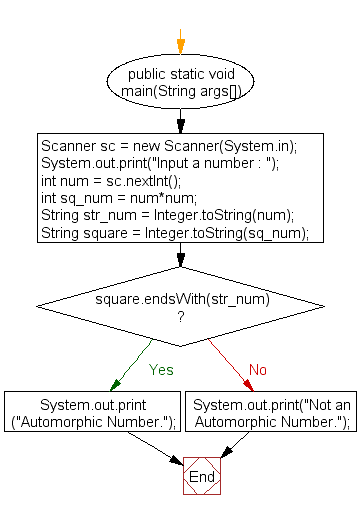Java: Check whether a number is an Automorphic number or not
Check Automorphic Number
Write a Java program to check whether a number is an automorphic number or not.
In mathematics, an automorphic number is a number whose square "ends" in the same digits as the number itself. For example, 52 = 25, 62 = 36, 762 = 5776, and 8906252 = 793212890625, so 5, 6, 76 and 890625 are all automorphic numbers.
Test Data
Input a number : 76
Pictorial Presentation:
Sample Solution:
Java Code:
import java.util.Scanner;
public class Example14 {
public static void main(String args[])
{
Scanner sc = new Scanner(System.in);
System.out.print("Input a number : ");
int num = sc.nextInt();
int sq_num = num*num;
String str_num = Integer.toString(num);
String square = Integer.toString(sq_num);
if(square.endsWith(str_num))
System.out.println("Automorphic Number.");
else
System.out.println("Not an Automorphic Number.");
}
}
Sample Output:
Input a number : 76 Automorphic Number.
Flowchart:

For more Practice: Solve these Related Problems:
- Write a Java program to determine if a number is automorphic by verifying that its square ends with the number itself.
- Write a Java program to generate automorphic numbers in a given range using string manipulation techniques.
- Write a Java program to recursively check the automorphic property by comparing remainders of powers of 10.
- Write a Java program to implement an automorphic number checker using arithmetic operations without string conversion.
Go to:
PREV : Check Pronic Number.
NEXT : Check Duck Number.
Java Code Editor:
Contribute your code and comments through Disqus.
What is the difficulty level of this exercise?
Test your Programming skills with w3resource's quiz.
